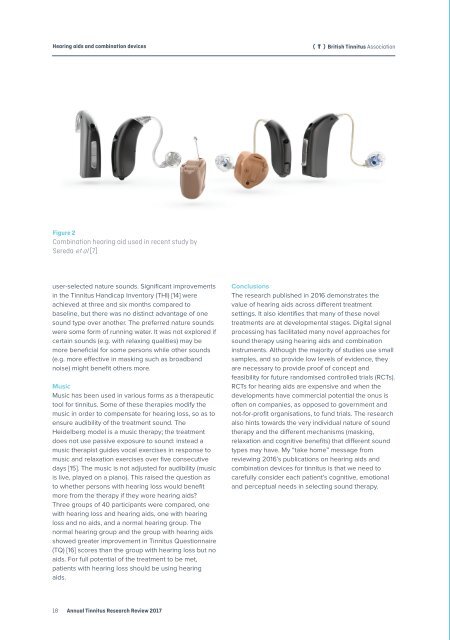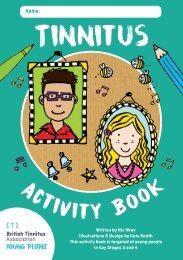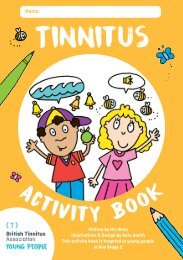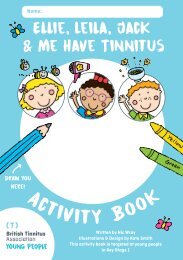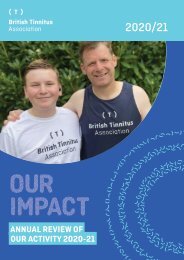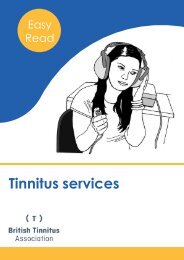Hearing Aids and Combination Devices
Create successful ePaper yourself
Turn your PDF publications into a flip-book with our unique Google optimized e-Paper software.
<strong>Hearing</strong> aids <strong>and</strong> combination devices T British Tinnitus Association<br />
Figure 2<br />
<strong>Combination</strong> hearing aid used in recent study by<br />
Sereda et al [7]<br />
user-selected nature sounds. Significant improvements<br />
in the Tinnitus H<strong>and</strong>icap Inventory (THI) [14] were<br />
achieved at three <strong>and</strong> six months compared to<br />
baseline, but there was no distinct advantage of one<br />
sound type over another. The preferred nature sounds<br />
were some form of running water. It was not explored if<br />
certain sounds (e.g. with relaxing qualities) may be<br />
more beneficial for some persons while other sounds<br />
(e.g. more effective in masking such as broadb<strong>and</strong><br />
noise) might benefit others more.<br />
Music<br />
Music has been used in various forms as a therapeutic<br />
tool for tinnitus. Some of these therapies modify the<br />
music in order to compensate for hearing loss, so as to<br />
ensure audibility of the treatment sound. The<br />
Heidelberg model is a music therapy; the treatment<br />
does not use passive exposure to sound: instead a<br />
music therapist guides vocal exercises in response to<br />
music <strong>and</strong> relaxation exercises over five consecutive<br />
days [15]. The music is not adjusted for audibility (music<br />
is live, played on a piano). This raised the question as<br />
to whether persons with hearing loss would benefit<br />
more from the therapy if they wore hearing aids?<br />
Three groups of 40 participants were compared, one<br />
with hearing loss <strong>and</strong> hearing aids, one with hearing<br />
loss <strong>and</strong> no aids, <strong>and</strong> a normal hearing group. The<br />
normal hearing group <strong>and</strong> the group with hearing aids<br />
showed greater improvement in Tinnitus Questionnaire<br />
(TQ) [16] scores than the group with hearing loss but no<br />
aids. For full potential of the treatment to be met,<br />
patients with hearing loss should be using hearing<br />
aids.<br />
Conclusions<br />
The research published in 2016 demonstrates the<br />
value of hearing aids across different treatment<br />
settings. It also identifies that many of these novel<br />
treatments are at developmental stages. Digital signal<br />
processing has facilitated many novel approaches for<br />
sound therapy using hearing aids <strong>and</strong> combination<br />
instruments. Although the majority of studies use small<br />
samples, <strong>and</strong> so provide low levels of evidence, they<br />
are necessary to provide proof of concept <strong>and</strong><br />
feasibility for future r<strong>and</strong>omised controlled trials (RCTs).<br />
RCTs for hearing aids are expensive <strong>and</strong> when the<br />
developments have commercial potential the onus is<br />
often on companies, as opposed to government <strong>and</strong><br />
not-for-profit organisations, to fund trials. The research<br />
also hints towards the very individual nature of sound<br />
therapy <strong>and</strong> the different mechanisms (masking,<br />
relaxation <strong>and</strong> cognitive benefits) that different sound<br />
types may have. My “take home” message from<br />
reviewing 2016’s publications on hearing aids <strong>and</strong><br />
combination devices for tinnitus is that we need to<br />
carefully consider each patient’s cognitive, emotional<br />
<strong>and</strong> perceptual needs in selecting sound therapy.<br />
18<br />
Annual Tinnitus Research Review 2017


